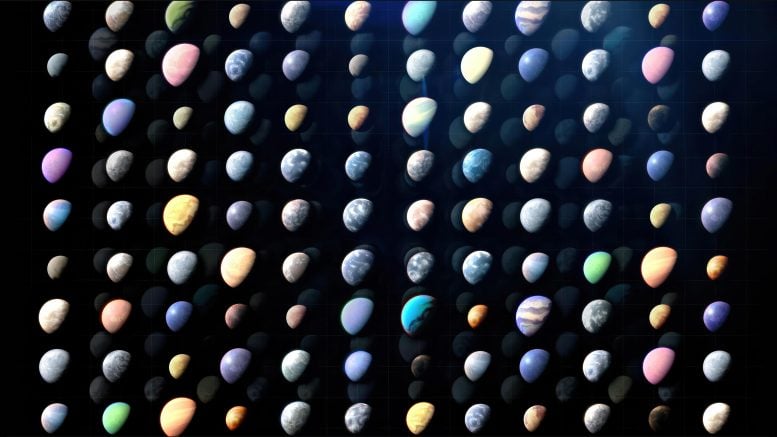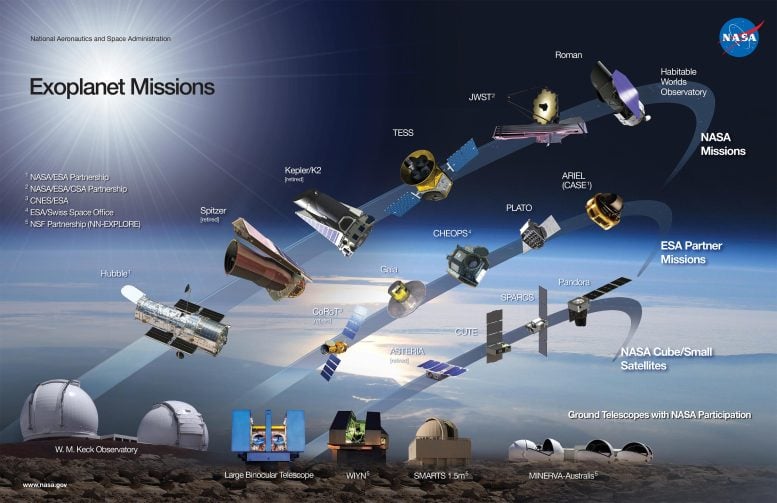NASA has now confirmed 6,000 exoplanets — a dazzling collection of alien worlds ranging from fiery giants and lava oceans to planets with clouds of gemstones or the density of Styrofoam.
This milestone not only highlights the staggering variety of worlds beyond our solar system but also marks humanity’s growing ability to find and study them.
NASA Reaches 6,000 Confirmed Exoplanets
NASA’s official count of confirmed exoplanets, meaning planets that orbit stars beyond our solar system, has now reached 6,000. New discoveries are added gradually by scientists worldwide, so there is no single planet designated as the 6,000th. The tally is maintained by NASA’s Exoplanet Science Institute (NExScI) at Caltech’s IPAC in Pasadena, California. More than 8,000 additional candidates are still awaiting confirmation, as NASA continues to lead the global effort to uncover signs of life beyond Earth.
“This milestone represents decades of cosmic exploration driven by NASA space telescopes — exploration that has completely changed the way humanity views the night sky,” said Shawn Domagal-Goldman, acting director, Astrophysics Division, NASA Headquarters in Washington. “Step by step, from discovery to characterization, NASA missions have built the foundation to answering a fundamental question: Are we alone? Now, with our upcoming Nancy Grace Roman Space Telescope and Habitable Worlds Observatory, America will lead the next giant leap — studying worlds like our own around stars like our Sun. This is American ingenuity, and a promise of discovery that unites us all.”

From First Discovery to Today
The 6,000 milestone comes three decades after the first exoplanet was confirmed around a Sun-like star in 1995. (Before that, a few planets had been detected orbiting stars that had already burned through their fuel and collapsed.) Scientists estimate there are billions of planets in the Milky Way, but spotting them remains difficult. As the catalog of confirmed exoplanets grows, researchers not only identify intriguing individual worlds but also gain perspective on how planetary systems compare with our own.
In our solar system, rocky planets and giant planets are balanced in number. Beyond it, rocky planets appear far more common. Researchers have also uncovered planetary types completely unlike anything nearby: Jupiter-sized worlds that orbit closer to their star than Mercury does to the Sun, planets circling two stars or none at all, dead-star companions, lava worlds, bodies so lightweight they resemble Styrofoam, and even planets with skies filled with gemstone clouds.
“Each of the different types of planets we discover gives us information about the conditions under which planets can form and, ultimately, how common planets like Earth might be, and where we should be looking for them,” said Dawn Gelino, head of NASA’s Exoplanet Exploration Program (ExEP), located at the agency’s Jet Propulsion Laboratory in Southern California. “If we want to find out if we’re alone in the universe, all of this knowledge is essential.”
It’s been 30 years because the discovery of the primary planet round one other star like our Solar. With each new discovery, scientists transfer nearer to answering whether or not there are different planets like Earth that might host life as we all know it. Credit score: NASA/JPL-Caltech
Trying to find Different Worlds
Fewer than 100 exoplanets have been straight imaged, as a result of most planets are so faint they get misplaced within the mild from their mum or dad star. The opposite 4 strategies of planet detection are oblique. With the transit methodology, as an illustration, astronomers search for a star to dim for a brief interval as an orbiting planet passes in entrance of it.
To account for the likelihood that one thing apart from an exoplanet is liable for a selected sign, most exoplanet candidates should be confirmed by follow-up observations, typically utilizing a further telescope, and that takes time. That’s why there’s a lengthy checklist of candidates within the NASA Exoplanet Archive (hosted by NExScI) ready to be confirmed.

Collaboration and Accelerating Discoveries
“We actually want the entire neighborhood working collectively if we need to maximize our investments in these missions which can be churning out exoplanet candidates,” stated Aurora Kesseli, the deputy science lead for the NASA Exoplanet Archive at IPAC. “A giant a part of what we do at NExScI is construct instruments that assist the neighborhood exit and switch candidate planets into confirmed planets.”
The speed of exoplanet discoveries has accelerated in recent times (the database reached 5,000 confirmed exoplanets simply three years in the past), and this development appears more likely to proceed. Kesseli and her colleagues anticipate receiving 1000’s of further exoplanet candidates from the ESA (European Space Agency) Gaia mission, which finds planets through a technique called astrometry, and NASA’s upcoming Nancy Grace Roman Space Telescope, which will discover thousands of new exoplanets primarily through a technique called gravitational microlensing.
The Future: Finding Earth-Like Planets
At NASA, the future of exoplanet science will focus on discovering rocky planets similar to Earth and studying their atmospheres for biosignatures — any characteristic, element, molecule, substance, or feature that can serve as evidence of past or present life. NASA’s James Webb Space Telescope has already analyzed the chemistry of over 100 exoplanet atmospheres.
But studying the atmospheres of planets the size and temperature of Earth will require new technology. Specifically, scientists need better tools to block the glare of the star a planet orbits. And in the case of an Earth-like planet, the glare would be significant: The Sun is about 10 billion times brighter than Earth — which would be more than enough to drown out our home planet’s light if viewed by a distant observer.
Roman Telescope and the Hunt for Liveable Worlds
NASA has two most important initiatives to attempt overcoming this hurdle. The Roman telescope will carry a expertise demonstration instrument referred to as the Roman Coronagraph that may check new applied sciences for blocking starlight and making faint planets seen. At its peak efficiency, the coronagraph ought to have the ability to straight picture a planet the dimensions and temperature of Jupiter orbiting a star like our Sun, and at a similar distance from that star. With its microlensing survey and coronagraphic observations, Roman will reveal new details about the diversity of planetary systems, showing how common solar systems like our own may be across the galaxy.
Additional advances in coronagraph technology will be needed to build a coronagraph that can detect a planet like Earth. NASA is working on a concept for such a mission, currently named the Habitable Worlds Observatory.
More about ExEP, NExScI
NASA’s Exoplanet Exploration Program (ExEP) leads the agency’s efforts to discover and understand planetary systems around nearby stars. Serving as the focal point for exoplanet science and technology, ExEP develops unified strategies that guide both current missions and future discoveries, with a strong emphasis on identifying potentially habitable worlds.
The program’s science operations and analysis hub is the NASA Exoplanet Science Institute (NExScI), located at IPAC (Caltech’s astrophysics and planetary science data center) in Pasadena, California. NExScI provides the tools, data, and coordination needed for the global research community to study exoplanets. Both ExEP and NExScI operate under the management of Caltech’s Jet Propulsion Laboratory (JPL) for NASA, ensuring scientific rigor and technological innovation remain at the forefront of exoplanet exploration.
Never miss a breakthrough: Join the SciTechDaily newsletter.

